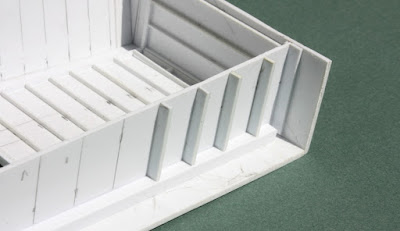(MRH remains on line, at www.mrhmag.com , but my column is now in their recently introduced supplement section called “Running Extra,” which takes a subscription to view — costing $2.99 for the single August issue, or with an annual subscription the cost is $1.67 a month — so I can’t offer you access to it without payment.)
I have seen this kind of layout-edge industry representation called a “fascia flat,” meaning that it is located at the fascia edge of the layout, but since mine can be seen through, I decided that the name “see-through industry” was more descriptive. The biggest advantage, of course, is that it takes up so little space, but there is a visual interest in being able to look through the doors or windows of such an industry.
I decided to make this structure have an open-framed interior wall, which of course is the wall we see from the layout aisle, and that in turn meant I needed to understand how prototype frame buildings are actually framed. For that, I turned to a truly superb book on the prototype, by noted architect Francis Ching. Shown below is the cover of the current 5th edition. You can readily find this title for sale on line, as a new book or, if you prefer, from used book sellers, either the 5th edition or one of the earlier editions.
This book is, to a lay person, remarkably complete and detailed, though to an experienced architect or carpenter is probably mostly old news.
I used styrene sheet and strip to build the building, as described in some detail in the MRH article, and though it was tedious at times, it ended up looking like I had hoped it would. Shown below is an in-progress photo from the article. Here you can see that all the wall studs and the top plate are installed, and I am in the process of installing floor joists. You can just see the underside of the roof at top left, and clearly rafters remain to be added.
Completion of the building included interior detailing of the part you can see, with a variety of tools, signs and placards, furniture, and workmen (you can click on the image to enlarge it if you like). Its name, Western Packing Company, is on the fascia, beneath a protective sheet of clear acrylic plastic. In this photo, what you see below the building is part of my layout staging.
This was a fun project to research and even to build (glossing over the tedious bits), and I am pretty pleased with the final result.
Tony Thompson




Thanks for this, Tony. Really useful. I've been musing on something similar for when I finally model 1954 Oceano in a space that may not be wide enough to allow full depiction of the buildings opposite the depot (Pismo-Oceano Vegetable Exchange and SP Milling/General Box). This will help immensely, should I have to bite the bullet.
ReplyDeleteYou're welcome, Brian. I assume you have photos of those structures -- if not let me know.
ReplyDeleteTony Thompson
Tony, thanks for this good information...even for us modern modelers. If you have an opportunity to check out the protogroups site maybe you can help identify a building for me named J. E Lancaster company? Thanks.
ReplyDelete